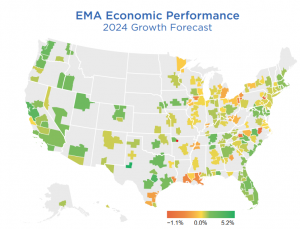For More Information
 Trying to interpret economic trends and dynamics can leave business owners, employers and others feeling like they’re translating a mystifying language. Empowering American Cities with Fifth Third Bank and UNC Kenan Institute offers a fresh approach to economic research tailored for local economies so leaders can position themselves for optimal growth and performance across America.
Trying to interpret economic trends and dynamics can leave business owners, employers and others feeling like they’re translating a mystifying language. Empowering American Cities with Fifth Third Bank and UNC Kenan Institute offers a fresh approach to economic research tailored for local economies so leaders can position themselves for optimal growth and performance across America.
The U.S. economy is composed of microeconomies from across the country, from large and midsize cities to small towns and rural areas, each with its own advantages and exposure to national trends. Understanding that investors, public officials and entrepreneurs are seeking local insights to fully comprehend economic health, Empowering American Cities uncovers the data and provides indicators revealing why some cities thrive while others fall behind. These economic insights empower leaders to put data at the center of their decision-making, driving investment in their companies, their hometowns and across the country.
Empowering American Cities pairs the proprietary statistical techniques and capabilities of the Kenan Institute of Private Enterprise, part of the University of North Carolina at Chapel Hill’s Kenan-Flagler Business School, and Fifth Third Bank’s 165-year heritage as a trusted regional bank.
Empowering American Cities Analysis: The Program
The Kenan Institute created Extended Metropolitan Areas (EMAs) as a designation for U.S. urban areas connected in economically meaningful ways and chose to study the 150 most populous EMAs, which account for nearly 90% of the U.S. economy. These range from New York City, with 24 million people and $2.5 trillion in economic output, to Wilmington, North Carolina, with a population of less than 300,000. 
Fifth Third Bank’s community-based banking teams work collaboratively with the Kenan Institute’s researchers to uncover specialized local factors for 30 selected EMAs. Together, they analyze precise drivers of growth and are developing indicators for labor supply, consumer demand and embedded growth characteristics in these areas.
These indicators will reveal the size of an area’s growth engine based on its distinct industry-level productivity, workforce skill level and demographics. The project’s quantitative and qualitative descriptions are discussed within the context of an area’s economic traits, which are usually the result of long-term investments in education and infrastructure.
Empowering American Cities Insight: How It’s Different
When we hear that the U.S. economy is growing, what does that mean for an individual business owner deciding on a factory expansion? What do the economics of those headlines mean for a city council planning legislative changes?
The nation experiences economic trends differently, not only across states and regions but also from industry to industry. U.S. microeconomies are economic engines and laboratories with varying approaches to planning and policy. By examining these economic units, we can determine indicators that are meaningful to various stakeholders. For example:
- Our economic modeling shows that cities like Austin and Seattle with strong technology and information sectors have built-in advantages that promote growth in an increasingly technology-driven macroeconomy.
- Areas that invest in infrastructure to train, attract and retain high-skilled workers, such as Nashville, are building productive and resilient local economies, reflected in recent exceptional growth. On the other hand, EMAs that are over reliant on a single sector are particularly exposed to fluctuations and disruptions in global markets and prone to boom-bust cycles.
- Neighboring cities can exhibit big differences in economic traits and outcomes. In the 10 years ending in 2023, the U.S. economy grew at a 2.3% annual rate. In North Carolina, Raleigh and Durham expanded 3.6% and Charlotte increased 3.2%, while Greensboro edged up just 0.6%. One reason lies in productivity: Both Raleigh and Durham and Charlotte have meaningfully higher shares of employment in the highly productive sectors of Information (3% and 2%, respectively) and Professional Scientific and Technical Services (11.6% and 6.7%) than Greensboro does (0.9% and 4%).
Empowering American Cities: Trusted Advice
Because our data more closely mirrors what’s happening in local economies across the country, we can effectively identify trends that shape business decisions to drive sustainable future growth. Fifth Third’s local experts, deeply embedded in the communities they serve, can translate these trends into meaningful opportunities. The Empowering American Cities website at EmpoweringAmericanCities.com allows users to compare their city’s economic characteristics, drivers of growth and other economic health indicators to 149 other metropolitan areas.
Users can leverage the data to support revenue forecasts, hiring and investment decisions, training programs, site planning and other key processes. There’s no need to look for a translator. Instead, clearly articulate a successful future with Empowering American Cities.
Explore more at EmpoweringAmericanCities.com.
